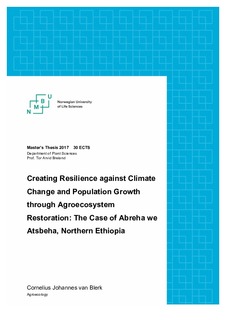| dc.description.abstract | In Africa, where 65% of the continent’s population use subsistence agriculture to create their livelihoods, projected changes to rainfall patterns, warmer average temperatures and rapid population growth will place increasing pressure on smallholder production systems. Landscape restoration is a strategy that aims to reverse land degradation and rebuild biodiversity in attempt to optimize the contribution that ecosystem services make to the resilience of the people. However, transformation of degraded landscapes into functional and mature agroecosystems is a slow and complex process, so there is a need to find ways to optimize the efficiency with which overall resilience is created. In order to address this objective, a qualitative study of a landscape undergoing restoration was conducted to form a holistic perspective of the relationships between processes of change and factors that influence resilience. The research, conducted in a semi-arid Ethiopian landscape that is vulnerable to climate change and population growth, used semi-structured interviews and observations of ten households on either side of the food-secure—food-insecure scale, to inform the discourse around pathways with the greatest potential for accelerating change. The study found that two main factors combine to influence resilience: (1) That a change to one part of the system that has a strengthening effect on household resilience, in the form of agricultural extension services that help farmers to increase yields by providing access to industrial inputs has an unanticipated limiting effect elsewhere in the system, in the form of ineffective dissemination of composting. (2) The effect that culture’s norms and traditions have on resilience, specifically the habit of cooking injera using fire that is fueled with manure and crop residue. The results of this study help to illuminate the ways that landscape restoration can be optimized so that greater overall resilience is achieved. New and ongoing landscape restoration projects must strike a balance between interventions aimed at short-term improvement of livelihood outcomes, and long-term strategies that aim to build resilience in anticipation of predicted changes. This can be achieved by creating awareness among local communities about the long-term benefits of building soil structure, so that they are willing to participate in developing new pathways to biomass recycling that is feasible for their specific landscape. | nb_NO |

